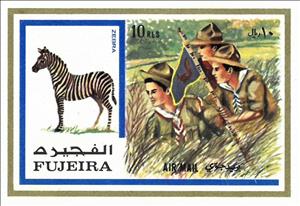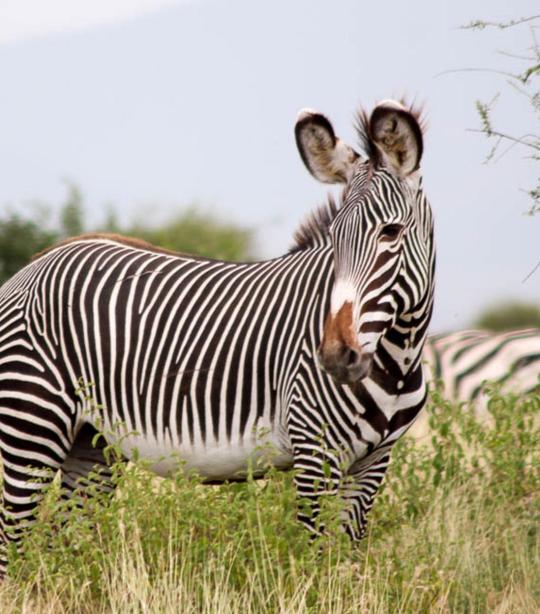Stamp: Zebra (Equus sp.); Boy Scouts (Fujairah (Fujeira) 1972)
Zebra (Equus sp.); Boy Scouts (Fujairah (Fujeira) 1972)
24 July (Fujairah (Fujeira) ) within release Pathfinder and animals goes into circulation Stamp Zebra (Equus sp.); Boy Scouts face value 10 United Arab Emirates riyal
| Stamp Zebra (Equus sp.); Boy Scouts in catalogues | |
|---|---|
| Michel: | Mi: FU 902B |
Stamp is square format.
Stamp from the mini-sheetAlso in the issue Pathfinder and animals:
- Souvenir Sheet - Scouts and Zebra (Equus sp.) face value 10;
- Stamp - Zebra (Equus sp.); Boy Scouts face value 10;
- Stamp - Asian Elephant (Elephas maximus), Baden-Powell visited the B face value 20;
- Stamp - Horse (Equus ferus caballus); Baden-Powell as a Cabin Boy face value 2;
- Stamp - Red Deer (Cervus elephus), Robert Baden-Powell as a Student face value 30;
- Stamp - Squirrel (Sciurus sp.); Baden-Powell and a Boy in the tactic face value 50;
- Stamp - White Horse (Equus ferus caballus); first Jamboree, Brownsea face value 3;
- Stamp - Wolf (Canis lupus); Baden-Powell hunts Wild Boar in India face value 1;
Stamp Zebra (Equus sp.); Boy Scouts it reflects the thematic directions:
Animals are multicellular, eukaryotic organisms of the kingdom Animalia (also called Metazoa). All animals are motile, meaning they can move spontaneously and independently, at some point in their lives. Their body plan eventually becomes fixed as they develop, although some undergo a process of metamorphosis later on in their lives. All animals are heterotrophs: they must ingest other organisms or their products for sustenance.
The horse (Equus ferus caballus) is one of two extant subspecies of Equus ferus. It is an odd-toed ungulate mammal belonging to the taxonomic family Equidae. The horse has evolved over the past 45 to 55 million years from a small multi-toed creature, Eohippus, into the large, single-toed animal of today. Humans began to domesticate horses around 4000 BC, and their domestication is believed to have been widespread by 3000 BC. Horses in the subspecies caballus are domesticated, although some domesticated populations live in the wild as feral horses. These feral populations are not true wild horses, as this term is used to describe horses that have never been domesticated, such as the endangered Przewalski's horse, a separate subspecies, and the only remaining true wild horse. There is an extensive, specialized vocabulary used to describe equine-related concepts, covering everything from anatomy to life stages, size, colors, markings, breeds, locomotion, and behavior.
Scouting, also known as the Scout Movement, is a worldwide youth social movement employing the Scout method. It is a program of informal education with an emphasis on practical outdoor activities, including camping, woodcraft, aquatics, hiking, backpacking, and sports. Another widely recognized movement characteristic is the Scout uniform, by intent hiding all differences of social standing in a country and encouraging equality, with neckerchief and campaign hat or comparable headwear. Distinctive uniform insignia include the fleur-de-lis and the trefoil, as well as merit badges and other patches.
Zebras (US: /ˈziːbrəz/, UK: /ˈzɛbrəz, ˈziː-/) (subgenus Hippotigris) are African equines with distinctive black-and-white striped coats. There are three living species: Grévy's zebra (Equus grevyi), the plains zebra (E. quagga), and the mountain zebra (E. zebra). Zebras share the genus Equus with horses and asses, the three groups being the only living members of the family Equidae. Zebra stripes come in different patterns, unique to each individual. Several theories have been proposed for the function of these patterns, with most evidence supporting them as a deterrent for biting flies. Zebras inhabit eastern and southern Africa and can be found in a variety of habitats such as savannahs, grasslands, woodlands, shrublands, and mountainous areas




